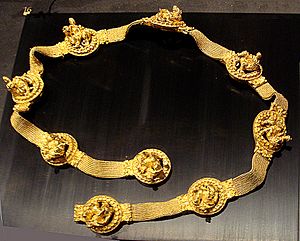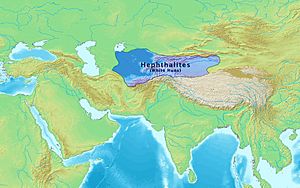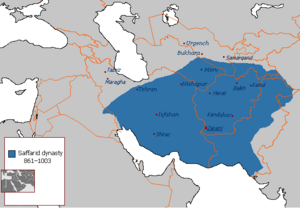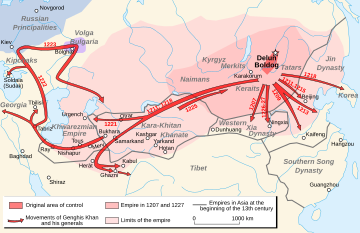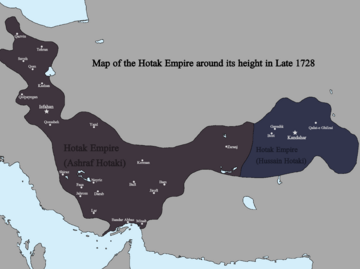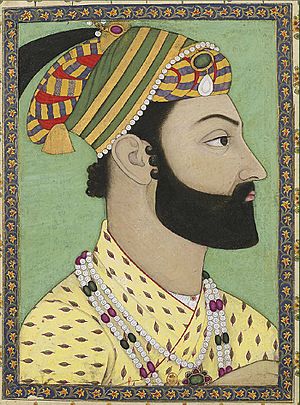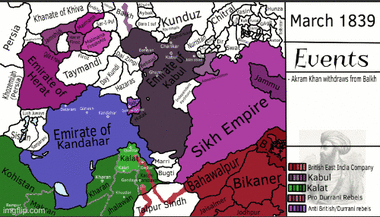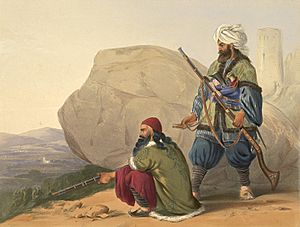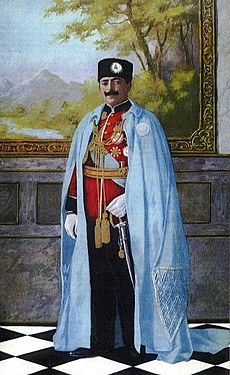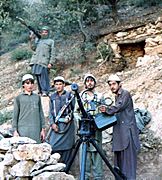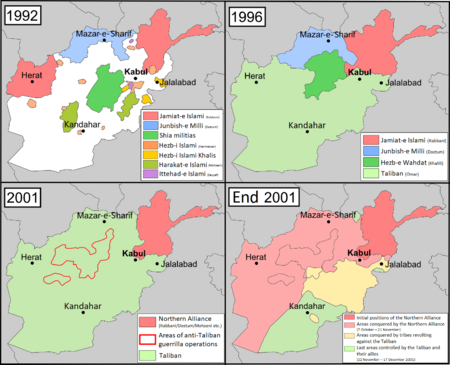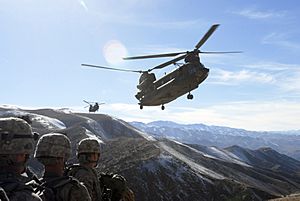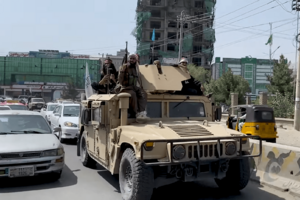History of Afghanistan facts for kids
Contents
Ancient history

Many empires and kingdoms have also risen to power in Afghanistan, such as the Greco-Bactrians, Indo-Scythians, Kushans, Kidarites, Hephthalites, Alkhons, Nezaks, Zunbils, Turk Shahis, Hindu Shahis, Lawiks, Saffarids, Samanids, Ghaznavids, Ghurids, Khaljis, Kartids, Lodis, Surs, Mughals, and finally, the Hotak and Durrani dynasties, which marked the political origins of the modern state. Throughout millennia several cities within the modern day Afghanistan served as capitals of various empires, namely, Bactra (Balkh), Alexandria on the Oxus (Ai-Khanoum), Kapisi, Sigal, Kabul, Kunduz, Zaranj, Firozkoh, Herat, Ghazna (Ghazni), Binban (Bamyan), and Kandahar.
The country has been home to various peoples through the ages, among them the ancient Iranian peoples, who established the dominant role of Indo-Iranian languages in the region. At multiple points, the land has been incorporated within vast regional empires; among them the Achaemenid Empire, the Macedonian Empire, the Maurya Empire, and the Islamic Empire. For its success in resisting foreign occupation during the 19th and 20th centuries, Afghanistan has been called the "graveyard of empires", though it is unknown who coined the phrase.
Prehistory and antiquity
Excavations of prehistoric sites suggest that humans were living in what is now Afghanistan at least 50,000 years ago, and that farming communities in the area were among the earliest in the world. An important site of early historical activities, many believe that Afghanistan compares to Egypt in terms of the historical value of its archaeological sites.
Ancient era
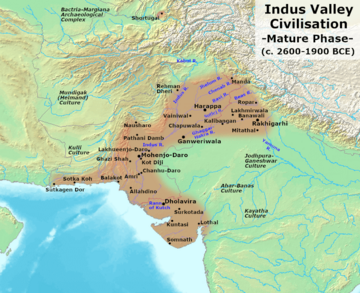
Archaeological exploration done in the 20th century suggests that the geographical area of Afghanistan has been closely connected by culture and trade with its neighbors to the east, west, and north. Artifacts typical of the Paleolithic, Mesolithic, Neolithic, Bronze, and Iron Ages have been found in Afghanistan. Urban civilization is believed to have begun as early as 3000 BCE, and the early city of Mundigak (near Kandahar in the south of the country) was a center of the Helmand culture. More recent findings established that the Indus Valley Civilization stretched up towards modern-day Afghanistan, making the ancient civilization today part of Pakistan, Afghanistan, and India. In more detail, it extended from what today is northwest Pakistan to northwest India and northeast Afghanistan. An Indus Valley site has been found on the Oxus River at Shortugai in northern Afghanistan. There are several smaller IVC colonies to be found in Afghanistan as well. An Indus Valley site has been found on the Oxus River at Shortugai in northern Afghanistan, which shows Afghanistan to have been a part of Indus Valley Civilization.
After 2000 BCE, successive waves of semi-nomadic people from Central Asia began moving south into Afghanistan; among them were many Indo-European-speaking Indo-Iranians. These tribes later migrated further into South Asia, Western Asia, and toward Europe via the area north of the Caspian Sea. The region at the time was referred to as Ariana.
By the middle of the 6th century BCE, the Achaemenids overthrew the Medes and incorporated Arachosia, Aria, and Bactria within its eastern boundaries. An inscription on the tombstone of Darius I of Persia mentions the Kabul Valley in a list of the 29 countries that he had conquered. The region of Arachosia, around Kandahar in modern-day southern Afghanistan, used to be primarily Zoroastrian and played a key role in the transfer of the Avesta to Persia and is thus considered by some to be the "second homeland of Zoroastrianism".
Alexander the Great and his Macedonian forces arrived in Afghanistan in 330 BCE after defeating Darius III of Persia a year earlier in the Battle of Gaugamela. Following Alexander's brief occupation, the successor state of the Seleucid Empire controlled the region until 305 BCE, when they gave much of it to the Maurya Empire as part of an alliance treaty. The Mauryans controlled the area south of the Hindu Kush until they were overthrown in about 185 BCE. Their decline began 60 years after Ashoka's rule ended, leading to the Hellenistic reconquest by the Greco-Bactrians. Much of it soon broke away from them and became part of the Indo-Greek Kingdom. They were defeated and expelled by the Indo-Scythians in the late 2nd century BCE.

The Silk Road appeared during the first century BCE, and Afghanistan flourished with trade, with routes to China, India, Persia, and north to the cities of Bukhara, Samarkand, and Khiva in present-day Uzbekistan. Goods and ideas were exchanged at this center point, such as Chinese silk, Persian silver and Roman gold, while the region of present Afghanistan was mining and trading lapis lazuli stones mainly from the Badakhshan region.
During the first century BCE, the Parthian Empire subjugated the region but lost it to their Indo-Parthian vassals. In the mid-to-late first century CE the vast Kushan Empire, centered in Afghanistan, became great patrons of Buddhist culture, making Buddhism flourish throughout the region. The Kushans were overthrown by the Sassanids in the 3rd century CE, though the Indo-Sassanids continued to rule at least parts of the region. They were followed by the Kidarites who, in turn, was replaced by the Hephthalites. They were replaced by the Turk Shahi in the 7th century. The Buddhist Turk Shahi of Kabul was replaced by a Hindu dynasty before the Saffarids conquered the area in 870, this Hindu dynasty was called Hindu Shahi. Much of the northeastern and southern areas of the country remained dominated by Buddhist culture.
Medieval history
Islamic conquest
Arab Muslims brought Islam to Herat and Zaranj in 642 CE and began spreading eastward; some of the native inhabitants they encountered accepted it while others revolted. Before the arrival of Islam, the region used to be home to various beliefs and cults, often resulting in Syncretism between the dominant religions such as Zoroastrianism, Buddhism or Greco-Buddhism, Ancient Iranian religions, Hinduism, Christianity, and Judaism. An exemplification of the syncretism in the region would be that people were patrons of Buddhism but still worshipped local Iranian gods such as Ahura Mazda, Lady Nana, Anahita or Mihr (Mithra) and portrayed Greek Gods like Heracles or Tyche as protectors of Buddha. The Zunbils and Kabul Shahi were first conquered in 870 CE by the Saffarid Muslims of Zaranj. Later, the Samanids extended their Islamic influence south of the Hindu Kush. It is reported that Muslims and non-Muslims still lived side by side in Kabul before the Ghaznavids rose to power in the 10th century.
By the 11th century, Mahmud of Ghazni defeated the remaining Hindu rulers and effectively Islamized the wider region, with the exception of Kafiristan. Mahmud made Ghazni into an important city and patronized intellectuals such as the historian Al-Biruni and the poet Ferdowsi. The Ghaznavid dynasty was overthrown by the Ghurids in 1186, whose architectural achievements included the remote Minaret of Jam. The Ghurids controlled Afghanistan for less than a century before being conquered by the Khwarazmian dynasty in 1215.
Mongols and Babur with the Lodi Dynasty
In 1219 CE, Genghis Khan and his Mongol army overran the region. His troops are said to have annihilated the Khwarazmian cities of Herat and Balkh as well as Bamyan. The destruction caused by the Mongols forced many locals to return to an agrarian rural society. Mongol rule continued with the Ilkhanate in the northwest while the Khalji dynasty administered the Afghan tribal areas south of the Hindu Kush until the invasion of Timur (aka Tamerlane), who established the Timurid Empire in 1370. Under the rule of Shah Rukh the city served as the focal point of the Timurid Renaissance, whose glory matched Florence of the Italian Renaissance as the center of a cultural rebirth.
In the early 16th century, Babur arrived from Ferghana and captured Kabul from the Arghun dynasty. Babur would go on to conquer the Afghan Lodi dynasty who had ruled the Delhi Sultanate in the First Battle of Panipat. Between the 16th and 18th century, the Uzbek Khanate of Bukhara, Iranian Safavids, and Indian Mughals ruled parts of the territory. During the Medieval Period, the northwestern area of Afghanistan was referred to by the regional name Khorasan. Two of the four capitals of Khorasan (Herat and Balkh) are now located in Afghanistan, while the regions of Kandahar, Zabulistan, Ghazni, Kabulistan, and Afghanistan formed the frontier between Khorasan and Hindustan. However, up to the 19th century the term Khorasan was commonly used among natives to describe their country; Sir George Elphinstone wrote with amazement that the country known to outsiders as "Afghanistan" was referred to by its own inhabitants as "Khorasan" and that the first Afghan official whom he met at the border welcomed him to Khorasan.
Modern history
Hotak Dynasty
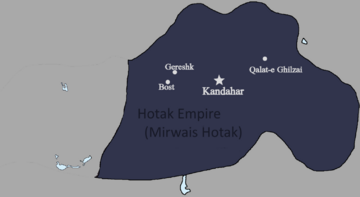
In 1709, Mirwais Hotak, a local Ghilzai tribal leader, successfully rebelled against the Safavids. He defeated Gurgin Khan, the Georgian governor of Kandahar under the Safavids, and established his own kingdom, also defeating many attempts for the Safavids to annex the Kingdom. Mirwais died of natural causes in 1715 and was succeeded by his brother Abdul Aziz, who was soon killed by Mirwais's son Mahmud for possibly planning to sign a peace with the Safavids. Mahmud led campaigns into modern Iran, with his first attempt in 1719 besieging Kerman, but this attempt failed. Mahmud led the Afghan army in 1722 to the Persian capital of Isfahan, and captured the city after the Battle of Gulnabad and proclaimed himself King of Persia. The Afghan dynasty was ousted from Persia by Nader Shah after the 1729 Battle of Damghan.
Fall of the Hotak Dynasty
In 1738, Nader Shah and his forces captured Kandahar in the siege of Kandahar, the last Hotak stronghold, from Shah Hussain Hotak. Soon after, the Persian and Afghan forces invaded India, Nader Shah had plundered Delhi, alongside his 16-year-old commander, Ahmad Shah Durrani who had assisted him on these campaigns. Nader Shah was assassinated in 1747.
Rise of the Durrani Empire
After the death of Nader Shah in 1747, Ahmad Shah Durrani had returned to Kandahar with a contingent of 4,000 Pashtuns. The Abdalis had "unanimously accepted" Ahmad Shah as their new leader. With his ascension in 1747, Ahmad Shah had led multiple campaigns against the Mughal Empire, Maratha Empire, and then-receding Afsharid Empire. Ahmad Shah had captured Kabul and Peshawar from the Mughal appointed governor, Nasir Khan. Ahmad Shah had then conquered Herat in 1750, and had also captured Kashmir in 1752. Ahmad Shah had launched two campaigns into Khorasan, (1750–1751) and (1754–1755). His first campaign had seen the siege of Mashhad, however, he was forced to retreat after four months. In November 1750, he moved to siege Nishapur, but he was unable to capture the city and was forced to retreat after heavy losses in early 1751. Ahmad Shah returned in 1754; he captured Tun, and on 23 July, he sieged Mashhad once again. Mashhad had fallen on 2 December, but Shahrokh was reappointed in 1755. He was forced to give up Torshiz, Bakharz, Jam, Khaf, and Turbat-e Haidari to the Afghans, as well as accept Afghan sovereignty. Following this, Ahmad Shah had sieged Nishapur once again, and captured it.
Objectives and Invasions of India
Ahmad Shah invaded India eight times during his reign. With the capture of Peshawar, Ahmad Shah had a convenient striking point to lead his military campaigns into Punjab and India.
Ahmad Shah had sought out multiple reasons for his invasions. He saw Afghanistan in a dire state, and one that needed to expand and exploit a weak but rich neighboring country, so he sought the reasons needed to fill his treasury in a conquest-based economy. Ahmad Shah launched his first invasion in 1748. Crossing the Indus River, his armies sacked and absorbed Lahore into the Durrani Realm. He met Mughal armies at the Battle of Manupur (1748), where he was defeated and forced to retreat to back to Afghanistan. He returned the next year in 1749 and captured the area around Lahore and Punjab, presenting it as an Afghan victory for this campaign. From 1749 to 1767, Ahmad Shah led six more invasions, the most important being the last; the Third Battle of Panipat created a power vacuum in northern India, halting Maratha expansion.
Death of Ahmad Shah and his successors
Ahmad Shah Durrani died in October 1772, and a civil war over succession followed, with his named successor, Timur Shah Durrani succeeding him after the defeat of his brother, Suleiman Mirza.
Timur Shah Durrani ascended to the throne in November 1772, having defeated a coalition under Shah Wali Khan, the influential prime minister of the Durrani Empire, and Humayun Mirza. Timur Shah began his reign by consolidating power toward himself and people loyal to him, purging Durrani Sardars and influential tribal leaders in Kabul and Kandahar to bring support toward himself. One of Timur Shah's reforms was to move the capital of the Durrani Empire from Kandahar to Kabul. Kabul was better as a base of operations since it was essentially the heartland of the empire, and Kabul is the modern capital of Afghanistan today. Timur Shah fought multiple series of rebellions to consolidate and hold the empire together, and he also led campaigns into Punjab against the Sikhs like his father, though more successfully. The most prominent example of his battles during this campaign was when he led his forces under Zangi Khan Durrani – with over 18,000 men total of Afghan, Qizilbash, and Mongol cavalrymen – against over 60,000 Sikh men. The Sikhs lost over 30,000 in this battle and staged a Durrani resurgence in the Punjab region The Durranis lost Multan in 1772 after Ahmad Shah's death. Following this victory by Timur Shah, Timur Shah was able to lay siege to Multan and recapture it, incorporating it into the Durrani Empire once again, reintegrating it as a province until the Siege of Multan (1818). Timur Shah was succeeded by his son Zaman Shah Durrani after his death on in May 1793. Timur Shah's reign oversaw the attempted stabilization and consolidation of the empire. However, Timur Shah had over 24 sons, which plunged the empire in civil war over succession crises.
Zaman Shah Durrani succeeded to the Durrani Throne following the death of his father, Timur Shah Durrani. His brothers Mahmud Shah Durrani and Humayun Mirza revolted against him, with Humayun centered in Kandahar and Mahmud Shah centered in Herat. Zaman Shah would defeat Humayun and force the loyalty of Mahmud Shah Durrani. Securing his position on the throne, Zaman Shah led three campaigns into Punjab. The first two campaigns captured Lahore, but he retreated due to intel about a possible Qajar invasion. Zaman Shah embarked on his third campaign for Punjab in 1800 to deal with a rebellious Ranjit Singh. However, he was forced to withdraw, and Zaman Shah's reign was ended by Mahmud Shah Durrani. However, just under two years in his reign, Mahmud Shah Durrani was deposed by his brother Shah Shuja Durrani (on 13 July 1803). Shah Shuja attempted to consolidate the Durrani Realm but was deposed by his brother at the Battle of Nimla (1809). Mahmud Shah Durrani defeated Shah Shuja and forced him to flee, usurping the throne again. His second reign began on 3 May 1809.
Barakzai dynasty and British wars
By the early 19th century, the Afghan empire was under threat from the Persians in the west and the Sikh Empire in the east. Fateh Khan, leader of the Barakzai tribe, installed many of his brothers in positions of power throughout the empire, mostly ruling as governors of major cities and provinces. Fateh Khan was murdered in 1818 by Mahmud Shah. As a result, the brothers of Fateh Khan and the Barakzai tribe rebelled, and a civil war brewed between the Sadozais and the Barakzais. During this turbulent period, Afghanistan fractured into many states. These included the Principality of Qandahar, Emirate of Herat, Khanate of Qunduz, Maimana Khanate, and many more states. The most prominent state was the Emirate of Kabul, ruled by Dost Mohammad Khan after he declared himself emir in summer 1826, having usurped the throne from his brother Sultan Mohammad Khan. He was later granted the title of Amir al-Mu'minin for waging jihad against the Sikhs in 1834. With the collapse of the Durrani Empire, and the exile of the Sadozai Dynasty to be left to rule in Herat while Afghanistan was in this turbulent period of civil war, Punjab and Kashmir were lost to Ranjit Singh, ruler of the Sikh Empire, who invaded Khyber Pakhtunkhwa in March 1823 and captured the city of Peshawar, placing the Peshawar Sardars under his suzerainty. (This was one of the many entities that split following the collapse of the Durrani Empire at the Battle of Nowshera.) In 1837, Dost Mohammad Khan attempted to retake Peshawar and sent a large force under his son Wazir Akbar Khan, leading to the Battle of Jamrud near the Khyber Pass. Akbar Khan and the Afghan army failed to capture the Jamrud Fort from the Sikh Khalsa Army, but killed Sikh Commander Hari Singh Nalwa, thus ending the Afghan-Sikh Wars. By this time the British were advancing from the east, conquering the Sikh Empire after it had its own period of turbulence following the death of Ranjit Singh, which engaged the Emirate of Kabul in the first major conflict during "The Great Game".
In 1839, a British expeditionary force marched into Afghanistan, invading the Principality of Qandahar, and in August 1839, seized Kabul, forcing Dost Mohammad into exile with other factions and rebels in Afghanistan. He was replaced with the former Durrani ruler Shah Shuja Durrani as the new ruler of Kabul, who was, unbeknownst to him, a de facto puppet on the throne. Following an uprising that saw the assassination of Shah Shuja, the 1842 retreat from Kabul of British-Indian forces and the annihilation of Elphinstone's army, and the punitive expedition of The Battle of Kabul that led to its sacking, the British gave up on their attempts to try and subjugate Afghanistan, which allowed Dost Mohammad Khan to return as ruler. He would spend most of his reign consolidating the parts of Afghanistan that were lost in the Afghan civil war which raged from 1793–1863. He launched numerous campaigns after returning to power in 1842, ruling only from Kabul, Ghazni, and other cities when he had returned. Dost Mohammad united most of the Afghan realm in his reign, securing the last major state, Herat, in the Herat campaign of 1862–1863. During his campaigns of re-unification, he held friendly relations with the British despite internal and external pressure to invade the British during the Sepoy mutiny, and affirmed their status toward each other in the Second Anglo-Afghan treaty of 1857. Dost Mohammad died on 9 June 1863, a few weeks after his campaign to capture Herat. Dost Mohammad's successors would fight for the throne of Afghanistan, between Sher Ali Khan, Mohammad Afzal Khan, and Mohammad Azam Khan in the Afghan Civil War (1863–1869). Sher Ali would win this civil war and would go on to rule the realm until 1878, when the British returned in the Second Anglo-Afghan War to fight over perceived Russian influence in the region. Abdur Rahman Khan replaced Ayub Khan, who had succeeded Sher Ali Khan after his death in 1879. Britain gained control of Afghanistan's foreign relations as part of the Treaty of Gandamak of 1879, making it an official British Protected State. In 1893, Amir Abdur Rahman signed an agreement in which the ethnic Pashtun and Baloch territories were divided by the Durand Line, which forms the modern-day border between Pakistan and Afghanistan. Shia-dominated Hazarajat and pagan Kafiristan remained politically independent until being conquered by Abdur Rahman Khan in 1891–1896. He was known as the "Iron Amir" for his features and his ruthless methods against tribes. He viewed railway and telegraph lines coming from the Russian and British as trojan horses and therefore prevented railway development in Afghanistan. He died in 1901, succeeded by his son, Habibullah Khan.
How can a small power like Afghanistan, which is like a goat between these lions [Britain and Russia] or a grain of wheat between two strong millstones of the grinding mill, [could] stand in the midway of the stones without being ground to dust?
During the First World War, when Afghanistan was neutral, Habibullah Khan was met by officials of the Central Powers in the Niedermayer–Hentig Expedition. They called on Afghanistan to declare full independence from the United Kingdom, join them and attack British India, as part of the Hindu–German Conspiracy. The effort to bring Afghanistan into the Central Powers failed, but it sparked discontent among the population about maintaining neutrality with the British. Habibullah was assassinated during a hunting trip in February 1919, and Amanullah Khan eventually assumed power. A staunch supporter of the 1915–1916 expeditions, Amanullah Khan provoked the Third Anglo-Afghan War, entering British India via the Khyber Pass.
After the end of the Third Anglo-Afghan War and the signing of the Treaty of Rawalpindi on 19 August 1919, Emir Amanullah Khan declared the Emirate of Afghanistan a sovereign and fully independent state. He moved to end his country's traditional isolation by establishing diplomatic relations with the international community, particularly with the Soviet Union and the Weimar Republic of Germany. He proclaimed himself King of Afghanistan on 9 June 1926, when the Emirate of Afghanistan became the Kingdom of Afghanistan. Following a 1927–1928 tour of Europe and Turkey, he introduced several reforms intended to modernize his nation. A key force behind these reforms was Mahmud Tarzi, an ardent supporter of the education of women. He fought for Article 68 of Afghanistan's 1923 constitution, which made elementary education compulsory. The institution of slavery was abolished in the Emirate of Afghanistan in 1923. King Amanullah's wife, Queen Soraya, was an important figure during this period in the fight for woman's education and against their oppression.
Some of the reforms that were put in place, such as the abolition of the traditional burqa for women and the opening of several co-educational schools, quickly alienated many tribal and religious leaders, and this led to the Afghan Civil War (1928–1929). Faced with the overwhelming armed opposition, King Amanullah abdicated in January 1929, and soon after Kabul fell to Saqqawist forces led by Habibullah Kalakani. Prince Mohammed Nadir Shah, Amanullah's cousin, in turn defeated and killed Kalakani in October 1929, and was declared King Nadir Shah. He abandoned the reforms of King Amanullah in favor of a more gradual approach to modernization, but was assassinated in 1933 by Abdul Khaliq, a 15-year-old Hazara student who was an Amanullah loyalist.
Mohammed Zahir Shah, Nadir Shah's 19-year-old son, succeeded to the throne and reigned as king from 1933 to 1973. During the tribal revolts of 1944–1947, King Zahir's reign was challenged by Zadran, Safi, Mangal, and Wazir tribesmen led by Mazrak Zadran, Salemai, and Mirzali Khan, among others – many of whom were Amanullah loyalists. Close relations with the Muslim states Turkey, the Hashemite Kingdom of Iraq and Iran/Persia were also pursued, while further international relations were sought by joining the League of Nations in 1934. The 1930s saw the development of roads, infrastructure, the founding of a national bank, and increased education. Road links in the north played a large part in a growing cotton and textile industry. The country built close relationships with the Axis powers, with Nazi Germany having the largest share in Afghan development at the time, along with the Kingdom of Italy and the Empire of Japan.
Afghanistan has performed the function in central Asia which Korea and Laos-Cambodia have performed in East and Southeast Asia: a regional flashpoint of colliding Great Power interests.
Contemporary history

Until 1946, King Zahir ruled with the assistance of his uncle, who held the post of prime minister and continued the policies of Nadir Shah. Another of Zahir Shah's uncles, Shah Mahmud Khan, became prime minister in 1946 and began an experiment allowing greater political freedom, but reversed the policy when it went further than he expected. He was replaced in 1953 by Mohammed Daoud Khan, the King's cousin and brother-in-law, and a Pashtun nationalist who sought the creation of a Pashtunistan, leading to highly tense relations with Pakistan. During his 10 years at the post (until 1963), Daoud Khan pressed for social modernization reforms and sought a closer relationship with the Soviet Union. Afterward, the 1964 constitution was formed, and the first non-royal prime minister was sworn in.
King Zahir Shah, like his father Nadir Shah, had a policy of maintaining national independence while pursuing gradual modernization, creating nationalist feeling, and improving relations with the United Kingdom. However, Afghanistan remained neutral and was neither a participant in World War II nor aligned with either power bloc in the Cold War thereafter. However, it was a beneficiary of the latter rivalry as both the Soviet Union and the United States vied for influence by building Afghanistan's main highways, airports, and other vital infrastructure in the post-war period. On a per capita basis, Afghanistan received more Soviet development aid than any other country. Afghanistan had, therefore, good relations with both Cold War enemies. In 1973, while the King was in Italy, Daoud Khan launched a bloodless coup and became the first president of Afghanistan, abolishing the monarchy.
Democratic Republic and Soviet war
In April 1978, the communist People's Democratic Party of Afghanistan (PDPA) seized power in a bloody coup d'état against then-President Mohammed Daoud Khan, in what is called the Saur Revolution. The PDPA declared the establishment of the Democratic Republic of Afghanistan, with its first leader named as People's Democratic Party General Secretary Nur Muhammad Taraki. This would trigger a series of events that would dramatically turn Afghanistan from a poor and secluded (albeit peaceful) country to a hotbed of international terrorism. The PDPA initiated various social, symbolic, and land distribution reforms that provoked strong opposition, while also brutally oppressing political dissidents. This caused unrest and quickly expanded into a state of civil war by 1979, waged by guerrilla mujahideen (and smaller Maoist guerrillas) against regime forces countrywide. It quickly turned into a proxy war as the Pakistani government provided these rebels with covert training centers, the United States supported them through Pakistan's Inter-Services Intelligence (ISI), and the Soviet Union sent thousands of military advisers to support the PDPA regime. Meanwhile, there was increasingly hostile friction between the competing factions of the PDPA – the dominant Khalq and the more moderate Parcham.
In September 1979, PDPA General Secretary Taraki was assassinated in an internal coup orchestrated by fellow Khalq member, then-prime minister Hafizullah Amin, who became the new general secretary of the People's Democratic Party. The situation in the country deteriorated under Amin, and thousands of people went missing. Displeased with Amin's government, the Soviet Army invaded the country in December 1979, heading for Kabul and killing Amin just three days later. A Soviet-organized regime, led by Parcham's Babrak Karmal but inclusive of both factions (Parcham and Khalq), filled the vacuum. Soviet troops in more substantial numbers were deployed to stabilize Afghanistan under Karmal, marking the beginning of the Soviet–Afghan War. The United States and Pakistan, along with smaller actors like Saudi Arabia and China, continued supporting the rebels, delivering billions of dollars in cash and weapons including two thousand FIM-92 Stinger surface-to-air missiles. Lasting nine years, the war caused the deaths of between 562,000 and 2 million Afghans, and displaced about 6 million people who subsequently fled Afghanistan, mainly to Pakistan and Iran. Heavy air bombardment destroyed many countryside villages, millions of landmines were planted, and some cities such as Herat and Kandahar were also damaged from bombardment. Pakistan's North-West Frontier Province functioned as an organizational and networking base for the anti-Soviet Afghan resistance, with the province's influential Deobandi ulama playing a major supporting role in promoting the "jihad". After the Soviet withdrawal, the civil war ensued until the communist regime under People's Democratic Party leader Mohammad Najibullah collapsed in 1992.
The Soviet-Afghan War had drastic social effects on Afghanistan. The militarization of society led to heavily armed police, private bodyguards, openly armed civil defense groups, and other such things becoming the norm in Afghanistan for decades thereafter. The traditional power structure had shifted from clergy, community elders, intelligentsia, and military in favor of powerful warlords.
Post–Cold War conflict
Another civil war broke out after the creation of a dysfunctional coalition government between leaders of various mujahideen factions. Amid a state of anarchy and factional infighting, various mujahideen factions committed widespread crimes, while Kabul was heavily bombarded and partially destroyed by the fighting. Several failed reconciliations and alliances occurred between different leaders. The Taliban emerged in September 1994 as a movement and militia of students (talib) from Islamic madrassas (schools) in Pakistan, who soon had military support from Pakistan. Taking control of Kandahar city that year, they conquered more territories until finally driving out the government of Rabbani from Kabul in 1996, where they established an emirate that gained international recognition from three countries: Pakistan, Saudi Arabia, and the United Arab Emirates. The Taliban were condemned internationally for the harsh enforcement of their interpretation of Islamic sharia law, which resulted in the brutal treatment of many Afghans, especially women. During their rule, the Taliban and their allies committed massacres against Afghan civilians, denied UN food supplies to starving civilians and conducted a policy of scorched earth, burning vast areas of fertile land and destroying tens of thousands of homes.
After the fall of Kabul to the Taliban, Ahmad Shah Massoud and Abdul Rashid Dostum formed the Northern Alliance, later joined by others, to resist the Taliban. Dostum's forces were defeated by the Taliban during the Battles of Mazar-i-Sharif in 1997 and 1998; Pakistan's Chief of Army Staff, Pervez Musharraf, began sending thousands of Pakistanis to help the Taliban defeat the Northern Alliance. By 2000, the Northern Alliance only controlled 10% of territory, cornered in the northeast. On 9 September 2001, Massoud was assassinated by two Arabs in Panjshir Valley. Around 400,000 Afghans died in internal conflicts between 1990 and 2001.
US invasion and Islamic Republic
In October 2001, the United States invaded Afghanistan to remove the Taliban from power after they refused to hand over Osama bin Laden, the prime suspect of the September 11 attacks, who was a "guest" of the Taliban and was operating his al-Qaeda network in Afghanistan. The majority of Afghans supported the American invasion of their country. During the initial invasion, US and UK forces bombed al-Qaeda training camps, and later working with the Northern Alliance, the Taliban regime came to an end.
In December 2001, after the Taliban government was overthrown, the Afghan Interim Administration under Hamid Karzai was formed. The International Security Assistance Force (ISAF) was established by the UN Security Council to help assist the Karzai administration and provide basic security. By this time, after two decades of war as well as an acute famine at the time, Afghanistan had one of the highest infant and child mortality rates in the world, the lowest life expectancy, much of the population were hungry, and infrastructure was in ruins. Many foreign donors started providing aid and assistance to rebuild the war-torn country.
Taliban forces meanwhile began regrouping inside Pakistan, while more coalition troops entered Afghanistan to help the rebuilding process. The Taliban began an insurgency to regain control of Afghanistan. Over the next decade, ISAF and Afghan troops led many offensives against the Taliban, but failed to fully defeat them. Afghanistan remained one of the poorest countries in the world because of a lack of foreign investment, government corruption, and the Taliban insurgency.
Meanwhile, Karzai attempted to unite the peoples of the country, and the Afghan government was able to build some democratic structures, adopting a constitution in 2004 with the name Islamic Republic of Afghanistan. Attempts were made, often with the support of foreign donor countries, to improve the country's economy, healthcare, education, transport, and agriculture. ISAF forces also began to train the Afghan National Security Forces. Following 2002, nearly five million Afghans were repatriated. The number of NATO troops present in Afghanistan peaked at 140,000 in 2011, dropping to about 16,000 in 2018.
In September 2014 Ashraf Ghani became president after the 2014 presidential election where for the first time in Afghanistan's history power was democratically transferred. On 28 December 2014, NATO formally ended ISAF combat operations in Afghanistan and transferred full security responsibility to the Afghan government. The NATO-led Operation Resolute Support was formed the same day as a successor to ISAF. Thousands of NATO troops remained in the country to train and advise Afghan government forces and continue their fight against the Taliban.
On 19 February 2020, the US–Taliban deal was made in Qatar. The 2020 US–Taliban deal was one of the critical events that caused the collapse of the Afghan National Security Forces (ANSF); following the signing of the deal, the US dramatically reduced the number of air attacks and deprived the ANSF of a critical edge in fighting the Taliban insurgency, leading to the Taliban takeover of Kabul.
Second Taliban era
NATO Secretary General Jens Stoltenberg announced on 14 April 2021 that the alliance had agreed to start withdrawing its troops from Afghanistan by 1 May. Soon after NATO troops began withdrawing, the Taliban launched an offensive against the Afghan government and quickly advanced in front of collapsing Afghan government forces. The Taliban captured the capital city of Kabul on 15 August 2021, after regaining control over a vast majority of Afghanistan. Several foreign diplomats and Afghan government officials, including president Ashraf Ghani, were evacuated from the country, with many Afghan civilians attempting to flee along with them. An unofficial "coordination council" led by senior statesmen was formed the next day to transfer the state institutions of the Islamic Republic of Afghanistan to the Taliban. On 17 August, first vice president Amrullah Saleh proclaimed himself caretaker president and announced the formation of an anti-Taliban front with a reported 6,000+ troops in the Panjshir Valley, along with Ahmad Massoud. However, by 6 September, the Taliban had taken control of most of Panjshir Province, with resistance fighters retreating to the mountains. Clashes in the valley ceased mid-September, as Saleh and Massoud had fled to neighboring Tajikistan.
According to the Costs of War Project, 176,000 people were killed in the conflict, including 46,319 civilians, between 2001 and 2021. According to the Uppsala Conflict Data Program, at least 212,191 people were killed in the conflict. Following the 2001 invasion, more than 5.7 million refugees returned to Afghanistan; however, in 2021, 2.6 million Afghans remained refugees, primarily in Iran and Pakistan, and another 4 million were internally displaced.
The Taliban government is led by supreme leader Hibatullah Akhundzada and acting prime minister Hasan Akhund, who took office on 7 September 2021. Akhund is one of the four founders of the Taliban and was a deputy prime minister of the previous emirate; his appointment was seen as a compromise between moderates and hardliners. A new, all-male cabinet was formed, which included Abdul Hakim Haqqani as minister of justice. On 20 September 2021, United Nations Secretary-General António Guterres received a letter from acting minister of foreign affairs Amir Khan Muttaqi to formally claim Afghanistan's seat as a member state for their official spokesman in Doha, Suhail Shaheen. The United Nations did not recognize the previous Taliban government and chose to work with the then-government in exile instead.
Western nations suspended most of their humanitarian aid to Afghanistan following the Taliban's August 2021 takeover of the country; the World Bank and International Monetary Fund also halted their payments. More than half of Afghanistan's 39 million people faced an acute food shortage in October 2021. Human Rights Watch reported on 11 November 2021 that Afghanistan was facing widespread famine due to an economic and banking crisis.
Though the state of war in the country ended in 2021, armed conflict persists in some regions amid fighting between the Taliban and the local branch of the Islamic State, as well as an anti-Taliban Republican insurgency. A year into Taliban rule, former president Hamid Karzai said in an interview: "In terms of [an] end to widespread fighting and conflict, we are happy – there's more stability, there's more security. But in terms of Afghanistan having a government that all Afghan people find themselves [in], we still have a way to go. In terms of the economy of the country, it's a disaster."
See also
 In Spanish: Historia de Afganistán para niños
In Spanish: Historia de Afganistán para niños


